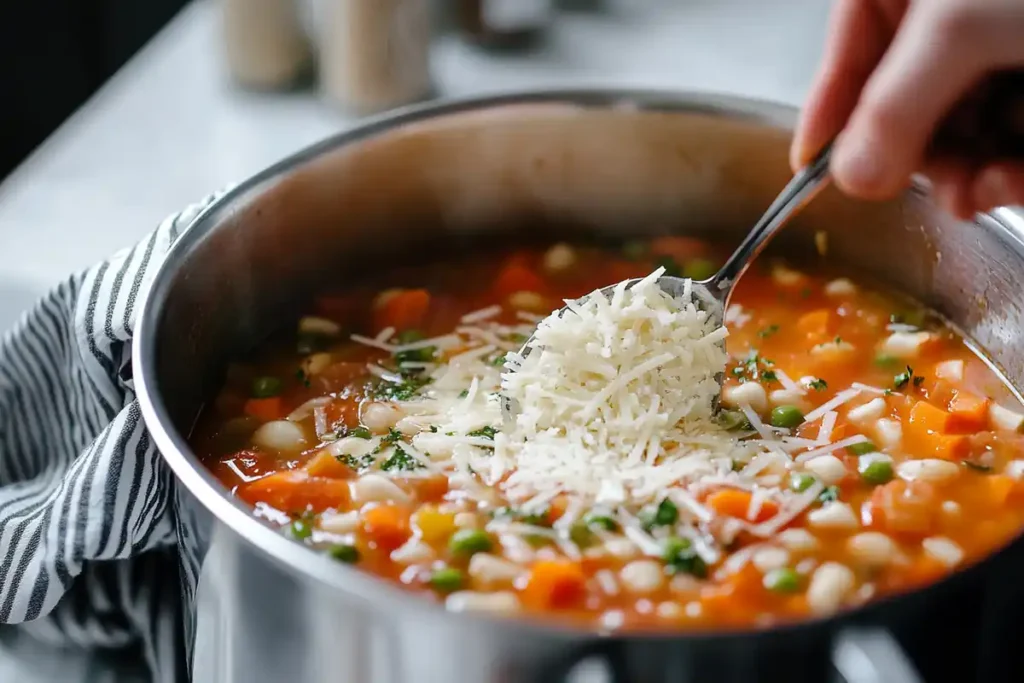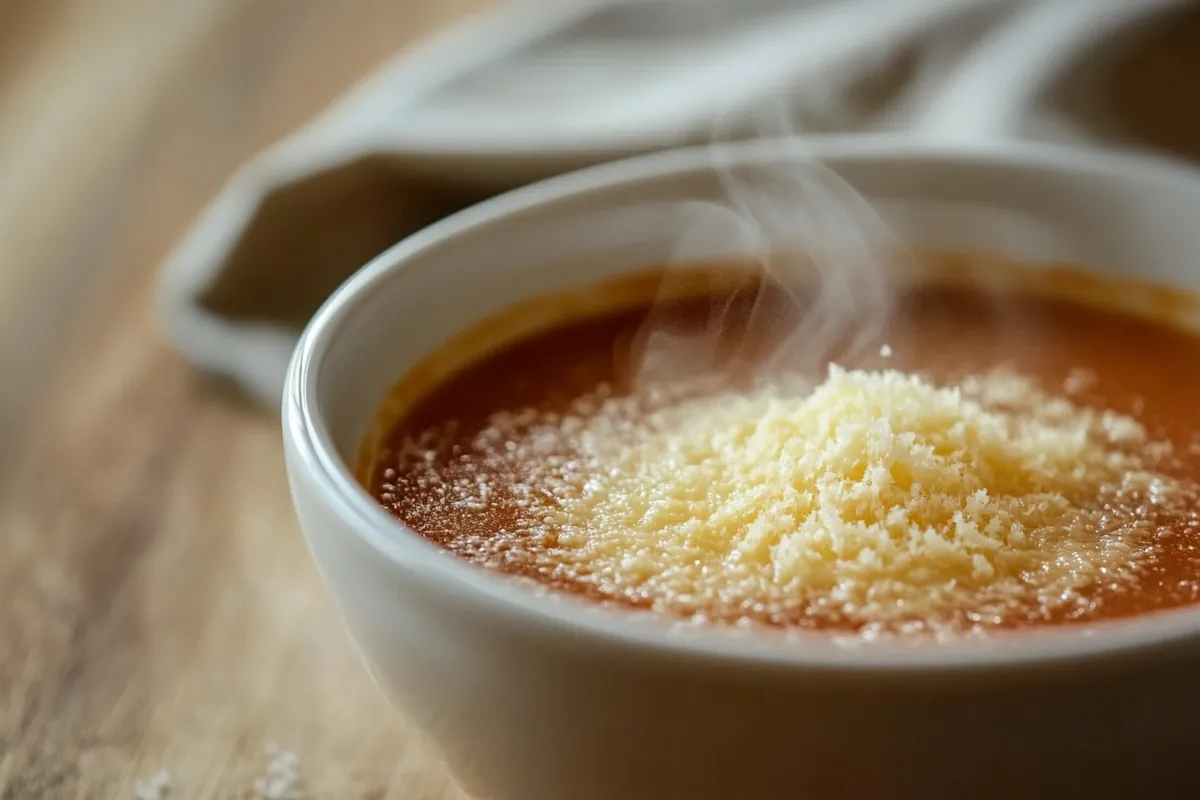Does Parmesan melt in soup? This article explores what happens when you add this cheese to your favorite recipes. We will also discuss tips and tricks for the best results.
Does Parmesan melt in soup? The simple answer is yes, but with a few nuances. This hard, aged cheese doesn’t melt quite like a soft mozzarella. However, it will soften and add its unique salty, umami flavor to your bowl. The way it melts, additionally, depends on how it’s prepared: grated, shredded, or as a rind. Let’s explore how this impacts your soup experience and how to best utilize it in your cooking. We will also discover ways that Parmesan can enhance your favorite soup recipes.
The Meltdown: How Does Parmesan Melt in Soup?
The melting process of Parmesan is different than other cheeses. Because it is a hard cheese, it doesn’t become gooey and stretchy. Does Parmesan melt in soup? Yes, it does, but instead of creating a stringy texture, it will soften. It will integrate into the liquid, imparting its distinct flavor. The heat of the soup helps this process. Therefore, you’ll find that grated or finely shredded Parmesan will disperse quite nicely. However, if you use a larger piece, such as a rind, the melting is different. Consequently, the melting process depends on the cheese’s preparation.
Grated Parmesan in Soup
Grated Parmesan is the most common form used in soups. Because of its small size, it disperses quickly. When added near the end of cooking, it will soften and partially dissolve. This process creates a smooth texture. It also delivers a powerful salty flavor. This is why it is ideal for adding a final touch of flavor. Additionally, it adds a nice umami to your broth. Therefore, many recipes call for a sprinkle of grated Parmesan. Finally, it’s a very easy way to add richness.
Shredded Parmesan in Soup

Shredded Parmesan behaves similarly to grated. However, because the pieces are slightly larger, it may take a bit longer to fully soften. Even so, it will still melt and blend into the soup. It does not melt as readily as softer cheeses. For example, it doesn’t become stringy like mozzarella. It will, however, melt and become smooth. As a result, the texture of the soup becomes richer. Thus, shredded parmesan is good for adding texture, too.
Parmesan Rinds: A Secret Ingredient
Using a Parmesan rind is another way to add flavor. Many people discard the rinds, but this is a mistake. The rind doesn’t melt in the traditional sense. However, it infuses the soup with flavor. While it will soften a bit, it mainly acts as a flavoring agent. This is achieved by simmering it in the soup. Therefore, the rind is usually removed before serving. Eventually, the result is a deep, savory note. This provides a unique depth of flavor.
Why Does Parmesan Melt in Soup Differently?
The melting behavior of Parmesan comes down to its characteristic structure. This is a result of the aging and production methods. Moreover, the way that cheese melts is directly linked to its composition. It has a low moisture content and high protein levels. These elements prevent it from becoming gooey. Therefore, it behaves differently than fresh cheeses. Furthermore, the aging process hardens the cheese. Consequently, it doesn’t melt as smoothly. Finally, the high salt content also plays a role.
Composition of Parmesan
Parmesan is primarily made of milk, salt, and rennet. Because of its long aging process, it loses much of its water content. This lack of moisture makes it hard and crumbly. Consequently, the protein structure becomes tighter. Therefore, it cannot melt into a stretchy liquid like softer cheeses. Because of this unique makeup, Parmesan melts differently. Nevertheless, this is a desired trait for many recipes.
The Role of Aging
The aging process is vital to Parmesan cheese. During this time, the cheese loses moisture. Additionally, its proteins change. This results in a harder texture. This also means that its melting properties change dramatically. Therefore, younger cheeses tend to melt easier. However, aged Parmesan, like that found in Italian recipes, melts differently. Finally, aging gives it a stronger flavor. It’s an important element of its appeal.
How to Use Parmesan in Soup
Now that we’ve discussed does Parmesan melt in soup, let’s consider how to best use it. The timing of the addition matters. Moreover, the form you choose will also affect the outcome. Always consider both factors for the best soup. This will help you achieve the desired flavor and texture. Let’s delve into some helpful suggestions.
Timing is Key
Adding Parmesan at the right time is vital. For example, grated or shredded Parmesan should be added toward the end of cooking. This allows it to soften and disperse, enhancing the soup’s flavor and texture. Does Parmesan melt in soup better when added at the end? Indeed, it does. Doing so avoids overcooking the cheese. Furthermore, it prevents a grainy texture. Therefore, timing matters when using Parmesan.
Grated vs. Shredded vs. Rind
As we have already seen, the form of Parmesan impacts how it behaves in the soup. Grated cheese melts quickly and evenly. Shredded cheese takes a little longer. However, both add a nice salty flavor. The rind, conversely, does not melt. It is used only for flavoring. Finally, it’s important to choose the right form for your recipe.
Best Types of Soup for Parmesan
Parmesan works well with a range of soups. For example, it compliments hearty Italian soups. These include minestrone and pasta fagioli. It also pairs well with tomato-based soups and creamy bisques. Therefore, consider these pairings for delicious meals. Its salty and savory notes enhance the existing flavors. Does Parmesan melt in soup well with any kind? While it works with many, it’s best for savory flavors.
The Benefits of Parmesan in Soup
Parmesan not only adds flavor but also some nutritional benefits. It’s a source of protein. Does Parmesan melt in soup and provide other benefits? Yes, it adds an umami-rich savory flavor, and also a dose of protein. Moreover, it’s a great way to enhance the richness of your soup. Let’s explore the different reasons why you should consider including it in your diet. This goes beyond flavor alone.
Flavor Enhancement
The main reason for using Parmesan in soup is its rich flavor. Its saltiness and umami add depth to any dish. In addition, it brings a savory note that other cheeses lack. Therefore, a little Parmesan can go a long way. Additionally, its robust profile improves the overall taste. Does Parmesan melt in soup and enhance the flavor? Definitely. This is its most loved trait.
Nutritional Value
Besides taste, Parmesan provides certain key nutrients. It’s a good source of protein. Moreover, it contains calcium. Therefore, it’s a good addition to a balanced diet. Does Parmesan melt in soup and contribute nutrients? Yes, it adds essential vitamins and minerals. However, it should be used in moderation.
Texture Improvement
Finally, Parmesan can affect the texture of the soup. Grated or shredded cheese adds a subtle creaminess. This makes the soup more satisfying. It also gives it a more substantial mouthfeel. Does Parmesan melt in soup and make it creamier? In fact, it can make the soup richer. This, consequently, enhances the whole eating experience.
Common Mistakes to Avoid
It’s easy to make a few mistakes when using Parmesan. For example, adding too much can overpower the soup’s flavor. Furthermore, adding it too early can cause it to become grainy. Therefore, it’s best to learn from others’ mistakes. This will help you achieve the best results. Let’s discuss some common errors to avoid.
Adding Too Much Parmesan
Adding too much Parmesan is a very common mistake. Too much cheese can make the soup too salty. Moreover, it can overwhelm the other flavors. Does Parmesan melt in soup well, even if it’s too much? It will, but the flavor might be unbalanced. Therefore, it’s essential to add it in moderation.
Adding it Too Early
Adding Parmesan too early in the cooking process can also be problematic. It may lead to a grainy texture. Moreover, it can cause the cheese to clump together. Thus, it is best to wait until the end. Does Parmesan melt in soup properly if added early? No, it does not melt as well and might become grainy.
Using the Wrong Type of Parmesan
Using the wrong type of Parmesan can also affect the result. For example, using pre-shredded cheese may not melt as smoothly. Also, using imitation Parmesan might lack the quality. Therefore, always choose high-quality, aged Parmesan. Does Parmesan melt in soup differently depending on its quality? Indeed, the quality makes a difference.
Tips for Perfect Parmesan in Soup
Achieving the perfect Parmesan result is not hard. It requires a little care and timing. For example, always add it at the end. Also, choose high-quality cheese. Moreover, use the right form. Consequently, you will get the best flavor and texture. Thus, let’s explore these helpful tips.
Freshly Grated is Best
Using freshly grated Parmesan is preferable. Does Parmesan melt in soup better when freshly grated? Yes, absolutely. This helps it melt more smoothly. It also provides the best flavor. Pre-grated cheese sometimes contains additives. Therefore, it won’t melt as well. Freshly grated cheese is simply superior.
Adding it at the End
As we have previously explored, adding Parmesan at the end is essential. This method ensures the cheese melts properly. It also prevents a grainy texture. Consequently, you’ll have a smoother soup. Does Parmesan melt in soup better when added last? Yes, this ensures the best possible outcome.
Taste as You Go
Taste as you go when adding Parmesan. This allows you to adjust the flavor to your preferences. You can always add more. However, you can’t take it away. Therefore, this practice will help you create a balanced taste. Moreover, this helps you avoid an overly salty result. Thus, it’s important to taste as you cook.
Exploring Parmesan Beyond the Basics
While we’ve covered the fundamentals of how does Parmesan melt in soup, there are more sophisticated techniques to consider. Moreover, the way you incorporate it can greatly enhance its impact. Let’s explore some advanced cooking methods. This will help you fully utilize Parmesan in your culinary endeavors. Ultimately, these tips will elevate your cooking experience.
Creating Parmesan Crisps

Consider making Parmesan crisps to add to your soup. These add a delightful crunchy element. You can create these by baking grated Parmesan on a sheet until it’s golden. Once cooled, crumble them over the soup. Does Parmesan melt in soup when baked like this? Yes, it melts and then hardens into a crisp. Consequently, the result is a satisfying contrast to the warm broth. Furthermore, they add another layer of flavor.
Infused Parmesan Oil
Another technique is to infuse Parmesan flavor into oil. Warm olive oil with Parmesan rinds. After that, let the mixture cool, strain, and use the oil as a finishing touch. This adds a subtle Parmesan note. Does Parmesan melt in soup well enough to infuse oil? No, it infuses the oil with its flavor. Consequently, the oil adds richness and aroma. It is a very sophisticated touch.
Parmesan and Broth Pairing
Pairing Parmesan with specific broths can also change the results. For example, it works well with chicken, beef, and vegetable broths. Moreover, it complements rich and hearty broths. Therefore, you should experiment with pairings. Does Parmesan melt in soup differently based on the broth? The broth’s flavor affects the overall taste. Hence, choose wisely.
Regional Variations and Recipes
Parmesan is a staple in many cuisines. Consequently, different regions use it in unique ways. For instance, Italy is the heartland of Parmesan. However, other places also use it. Additionally, these regions have also developed special recipes. Thus, exploring these variations is worthwhile. It can inspire you to try new things in the kitchen. Ultimately, it is a globally loved cheese.
Italian Parmesan Soup Recipes
In Italy, Parmesan is often used in classic recipes. Does Parmesan melt in soup differently when it is used in traditional Italian recipes? No, the cheese still behaves the same way, but the overall flavor and experience are different. For instance, it might be used in a hearty ribollita soup or a minestrone. Additionally, it might be served with a simple pasta in broth. Therefore, exploring these classics is important.
Parmesan in French Soups
French cuisine also uses Parmesan. It might not be as prevalent as in Italian cuisine. However, it’s still used. It adds a layer of flavor and richness to certain soups. Does Parmesan melt in soup in a French style? Yes, it still melts the same way, but it may be paired with different flavors. For example, it might be used in a creamy vegetable soup. This adds a unique twist.
Global Usage of Parmesan
Beyond Europe, Parmesan has found its way into various dishes. It’s used in many fusion recipes worldwide. Does Parmesan melt in soup in these diverse applications? Yes, it continues to melt and add its unique flavor. It’s added to soups in different ways, showcasing its versatility. The different cultures have created unique recipes. Therefore, it’s a truly versatile cheese.
Storing and Selecting Parmesan
Knowing how to select and store Parmesan is key. Moreover, proper storage keeps the cheese fresh. Always choose good quality cheese. This will ensure the best flavor. Does Parmesan melt in soup better when stored properly? The way it melts is the same but the quality impacts flavor. Let’s discuss some valuable tips for purchasing and storage.
Choosing the Right Parmesan
Look for high-quality Parmesan when buying. The color should be pale yellow. Moreover, it should have a firm, granular texture. Always buy from reputable sources. Does Parmesan melt in soup better when it’s high quality? Yes, quality impacts flavor and melting consistency. High-quality Parmesan will have a more intense flavor. Therefore, always shop for the best.
Proper Storage Methods
To store Parmesan, wrap it tightly. Use plastic wrap or a reusable container. Store it in the refrigerator. Keep it away from moisture. Does Parmesan melt in soup that hasn’t been stored properly? Yes, but the flavor may be diminished. Proper storage maintains its quality. Finally, this ensures you’ll get the best flavor.
Shelf Life of Parmesan
Parmesan has a relatively long shelf life. However, it’s still best to use it within a reasonable timeframe. Moreover, its quality can degrade over time. Therefore, always check the date on the package. Does Parmesan melt in soup differently after a long shelf life? No, but the flavor might have changed. Keeping an eye on the date will ensure good taste.
Understanding the Science Behind Melting
The science of cheese melting is quite complex. It depends on various factors. For example, the cheese’s structure, composition, and moisture content. Understanding this will improve your cooking techniques. Does Parmesan melt in soup based on this science? Indeed, it’s this science that makes Parmesan melt the way it does. Let’s delve into this a bit deeper.
The Role of Proteins
The proteins in cheese play a large role in its melting. These proteins create a network. This network defines the structure. In Parmesan, the proteins are tightly bound. Therefore, it doesn’t become as liquid. Does Parmesan melt in soup differently due to its protein network? Yes, the network is the key to its melting behavior. Consequently, this unique protein structure makes it hard.
The Effect of Moisture
Moisture content is another vital factor. Parmesan has a low moisture content. This contributes to its hard texture. It also impacts how it melts. Cheeses with higher moisture content melt more easily. Does Parmesan melt in soup well with its low moisture? Yes, it still melts but not in a liquid form. Low moisture makes it behave differently.
Temperature and Melting
Finally, temperature also plays a major role. High heat helps cheese melt. However, excessive heat can also cause the cheese to separate. This is why you need to add Parmesan near the end. Does Parmesan melt in soup best at certain temperatures? Yes, moderate heat is best for melting it smoothly. High heat can damage its texture. Thus, controlling the heat is essential.
Conclusion: The Art of Using Parmesan in Soup
Does Parmesan melt in soup? Yes, indeed, it does. However, the way it melts depends on several factors. It does not melt like other cheeses, but it can transform your recipe. Moreover, it can add flavor, nutrients, and texture. Therefore, consider these factors when adding Parmesan. By knowing the basics, you can improve your cooking. Finally, this delicious cheese is a very versatile addition.
Frequently Asked Questions (FAQs):
Will Parmesan thicken soup?
Parmesan cheese does not typically act as a significant thickening agent in soup. It might add some richness and body to a soup, but it won’t thicken it like a starch or a cream would.
Is Parmesan cheese a thickener?
No, Parmesan cheese is not primarily a thickener. Its main contribution is to add flavor, and when it melts, it creates a richer texture in the soup. It’s not designed or used as a thickening agent.
What does putting Parmesan rind in soup do?
Adding a Parmesan rind to soup infuses the broth with a deep, savory, umami flavor. The rind doesn’t melt, but it releases its flavors as it simmers. The rind should be removed before serving.
Will cheese thicken soup?
While some cheeses, such as cream cheese or processed cheese, can thicken soup because of their higher fat and moisture content, Parmesan will mostly melt and add flavor rather than thicken the soup significantly.

